GNSS Receiver-Related Pseudorange Biases: Characteristics and Effects on Wide-Lane Ambiguity Resolution
Abstract
1. Introduction
2. Methodology
2.1. Observation Model
2.2. Data Collection
3. Results
3.1. Baselines with the Same Receiver Types
3.2. Baselines with Mixed Receiver Types
3.3. Pseudorange Biases Stabilities
3.4. Impacts on Short Baseline Solutions
4. Discussion
5. Conclusions
Author Contributions
Funding
Institutional Review Board Statement
Informed Consent Statement
Data Availability Statement
Acknowledgments
Conflicts of Interest
References
- Hein, G.W. Status, perspectives and trends of satellite navigation. Satell. Navig. 2020, 1, 1–12. [Google Scholar] [CrossRef]
- Barnes, D. GPS status and modernization. In Proceedings of the Munich Satellite Navigation Summit, Munich, Germany, 27 March 2019. [Google Scholar]
- Benedicto, J. Directions 2020: Galileo moves ahead. GPS World 2019, 30, 38–41, 46–47. [Google Scholar]
- China Satellite Navigation Office. Development of the BeiDou Navigation Satellite System, 4th ed.; CSNO: Beijing, China, 2019. [Google Scholar]
- Langley, R.B. Innovation: GLONASS—Past, present and future. GPS World 2017, 28, 44–49. [Google Scholar]
- Li, X.; Ge, M.; Dai, X.; Ren, X.; Fritsche, M.; Wickert, J.; Schuh, H. Accuracy and reliability of multi-GNSS real-time precise positioning: GPS, GLONASS, BeiDou, and Galileo. J. Geod. 2015, 89, 607–635. [Google Scholar] [CrossRef]
- Gao, W.; Gao, C.; Pan, S.; Wang, D.; Deng, J. Improving ambiguity resolution for medium baselines using combined GPS and BDS dual/triple-frequency observations. Sensors 2015, 15, 27525–27542. [Google Scholar] [CrossRef] [PubMed]
- Tang, W.; Deng, C.; Shi, C.; LIU, J. Triple-frequency carrier ambiguity resolution for Beidou navigation satellite system. GPS Solut. 2014, 18, 335–344. [Google Scholar] [CrossRef]
- Montenbruck, O.; Steigenberger, P.; Khachikyan, R.; Weber, G.; Langley, R.B.; Mervart, L.; Hugentobler, U. IGS-MGEX: Preparing the ground for multi-constellation GNSS science. Inside GNSS 2014, 9, 42–49. [Google Scholar]
- Montenbruck, O.; Steigenberger, P.; Prange, L.; Deng, Z.; Zhao, Q.; Perosanz, F.; Romero, I.; Noll, C.; Stürze, A.; Weber, G.; et al. The Multi-GNSS Experiment (MGEX) of the International GNSS Service (IGS)–Achievements, prospects and challenges. Adv. Space Res. 2017, 59, 1671–1697. [Google Scholar] [CrossRef]
- Xue, J.; Song, S.; Zhu, W. Estimation of differential code biases for Beidou navigation system using multi-GNSS observations: How stable are the differential satellite and receiver code biases? J. Geod. 2016, 90, 309–321. [Google Scholar] [CrossRef]
- Coco, D.S.; Coker, C.; Dahlke, S.R.; Clynch, J.R. Variability of GPS satellite differential group delay biases. IEEE Trans. Aerosp. Electron. Syst. 1991, 27, 931–938. [Google Scholar] [CrossRef]
- Choi, B.K.; Cho, J.H.; Lee, S.J. Estimation and analysis of GPS receiver differential code biases using KGN in Korean Peninsula. Adv. Space Res. 2011, 47, 1590–1599. [Google Scholar] [CrossRef]
- Ge, Y.; Zhou, F.; Sun, B.; Wang, S.; Shi, B. The impact of satellite time group delay and inter-frequency differential code bias corrections on multi-GNSS combined positioning. Sensors 2017, 17, 602. [Google Scholar] [CrossRef] [PubMed]
- Chen, Y.; Yuan, Y.; Zhang, B.; Liu, T.; Ding, W.; Ai, Q. A modified mix-differenced approach for estimating multi-GNSS real-time satellite clock offsets. GPS Solut. 2018, 22, 72. [Google Scholar] [CrossRef]
- Hauschild, A.; Montenbruck, O.; Sleewaegen, J.; Huisman, L.; Teunissen, G. Characterization of Compass M-1 signals. GPS Solut. 2012, 16, 117–126. [Google Scholar] [CrossRef]
- Gisbert, J.V.P.; Batzilis, N.; Risueno, G.L.; Rubio, J.A. GNSS payload and signal characterization using a 3 m dish antenna. In Proceedings of the 25th International Technical Meeting of the Satellite Division of The Institute of Navigation (ION GNSS 2012), Nashville, TN, USA, 17–21 September 2012; pp. 347–356. [Google Scholar]
- Montenbruck, O.; Rizos, C.; Weber, R.; Weber, G.; Neilan, R.; Hugentobler, U. Getting a grip on multi-GNSS—The international GNSS service MGEX campaign. GPS World 2013, 24, 44–49. [Google Scholar]
- Wanninger, L.; Beer, S. BeiDou satellite-induced code pseudorange variations: Diagnosis and therapy. GPS Solut. 2015, 19, 639–648. [Google Scholar] [CrossRef]
- Lou, Y.; Gong, X.; Gu, S.; Zheng, F.; Feng, Y. Assessment of code bias variations of BDS triple-frequency signals and their impacts on ambiguity resolution for long baselines. GPS Solut. 2017, 21, 177–186. [Google Scholar] [CrossRef]
- Geng, T.; Xie, X.; Zhao, Q.; Liu, X.; Liu, J. Improving BDS integer ambiguity resolution using satellite-induced code bias correction for precise orbit determination. GPS Solut. 2017, 21, 1191–1201. [Google Scholar] [CrossRef]
- Jiang, K.; Li, M.; Zhao, Q.; Li, W.; Guo, X. BeiDou geostationary satellite code bias modeling using fengyun-3C onboard measurements. Sensors 2017, 17, 2460. [Google Scholar] [CrossRef]
- Phelts, R.E.; Akos, D.M. Effects of signal deformations on modernized GNSS signals. J. Glob. Position. Syst. 2006, 5, 1–10. [Google Scholar] [CrossRef]
- Hauschild, A.; Montenbruck, O. A study on the dependency of GNSS pseudorange biases on correlator spacing. GPS Solut. 2016, 20, 159–171. [Google Scholar] [CrossRef]
- Hauschild, A.; Montenbruck, O. The effect of correlator and front-end design on GNSS pseudorange biases for geodetic receivers. Navigation 2016, 63, 443–453. [Google Scholar] [CrossRef]
- Lestarquit, L.; Gregoire, Y.; Thevenon, P. Characterizing the GNSS correlation function using a high gain antenna and long coherent integration—Application to signal quality monitoring. In Proceedings of the IEEE/ION: Position Location and Navigation System Conference 2012, Myrtle Beach, SC, USA, 23–26 April 2012; pp. 877–885. [Google Scholar]
- Wong, G.; Phelts, R.; Walter, T.; Enge, P. Alternative characterization of analog signal deformation for GNSS-GPS satellites. In Proceedings of the International Technical Meeting of the Institute of Navigation 2011, San Diego, CA, USA, 24–26 January 2011; pp. 497–507. [Google Scholar]
- Wong, G.; Chen, Y.; Phelts, E.; Walter, T.; Enge, P. Measuring code-phase differences due to inter-satellite hardware differences. In Proceedings of the 25th International Technical Meeting of The Satellite Division of the Institute of Navigation 2012 (ION GNSS 2012), Nashville, TN, USA, 17–21 September 2012. [Google Scholar]
- Hauschild, A.; Steigenberger, P.; Montenbruck, O. Inter-receiver GNSS pseudorange biases and their effect on clock and DCB estimation. In Proceedings of the 32nd International Technical Meeting of the Satellite Division of The Institute of Navigation (ION GNSS + 2019), Miami, FL, USA, 16–20 September 2019; pp. 3675–3685. [Google Scholar]
- Zheng, F.; Gong, X.; Lou, Y.; Gu, S.; Jing, G.; Shi, C. Calibration of BeiDou triple-frequency receiver-related pseudorange biases and their application in BDS precise positioning and ambiguity resolution. Sensors 2019, 19, 3500. [Google Scholar] [CrossRef] [PubMed]
- Gong, X.; Lou, Y.; Zheng, F.; Gu, S.; Shi, C.; Liu, J.; Jing, G. Evaluation and calibration of BeiDou receiver-related pseudorange biases. GPS Solut. 2018, 22, 98. [Google Scholar] [CrossRef]
- Xin, L. Algorithm Study with GPS/BDS and PL High Precise RTK Positioning. Ph.D. Thesis, Wuhan University, Wuhan, China, June 2017. [Google Scholar]
- Bao, N. Research on RTK Positioning Performance of BeiDou Navigation Satellite System. Master’s Thesis, Civil Aviation University of China, Tianjin, China, May 2019. [Google Scholar]
- Tang, C.; Su, C.; Hu, X.; Gao, W.; Liu, L.; Lu, Y.; Chen, Y.; Liu, C.; Wang, W.; Zhou, S. Characterization of pesudorange bias and its effect on positioning for BDS satellites. Acta Geod. Cartogr. Sin. 2020, 49, 1131–1138. [Google Scholar] [CrossRef]
- Shuai, L. Theories and Methods in Tight Integration of Ambiguity fixed PPP and INS. Ph.D. Thesis, PLA Information Engineering University, Beijing, China, June 2012. [Google Scholar]
- Hatch, R. The synergism of GPS code and carrier measurements. In Proceedings of the Third International Symposium on Satellite Doppler Positioning, Las Cruces, NM, USA, 8–12 February 1982; pp. 1213–1231. [Google Scholar]
- Melbourne, W.G. The case for ranging in GPS based geodetic systems. In Proceedings of the First International Symposium on Precise Positioning with the Global Positioning System, Rockville, MD, USA, 15–19 April 1985; pp. 373–386. [Google Scholar]


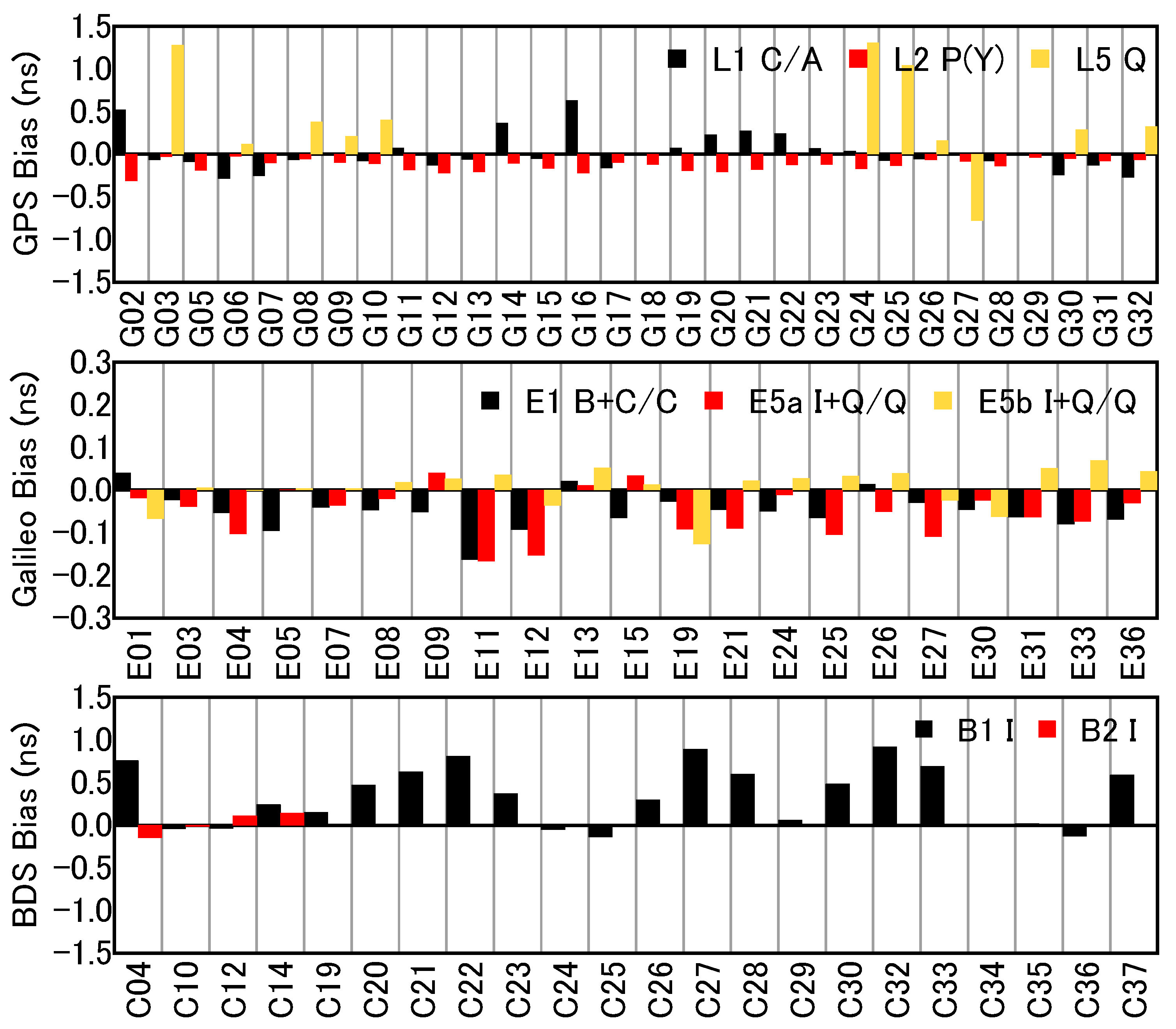
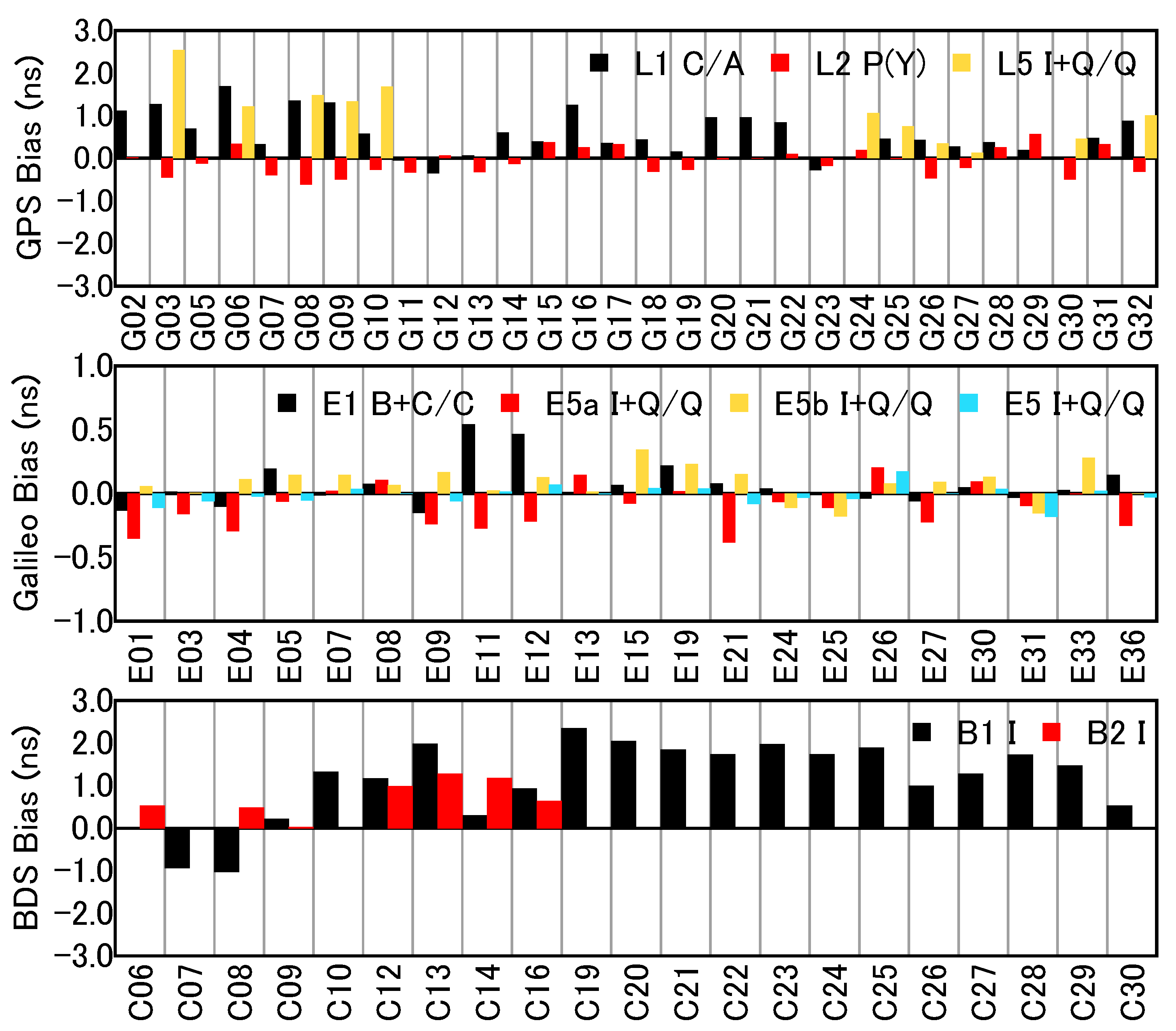
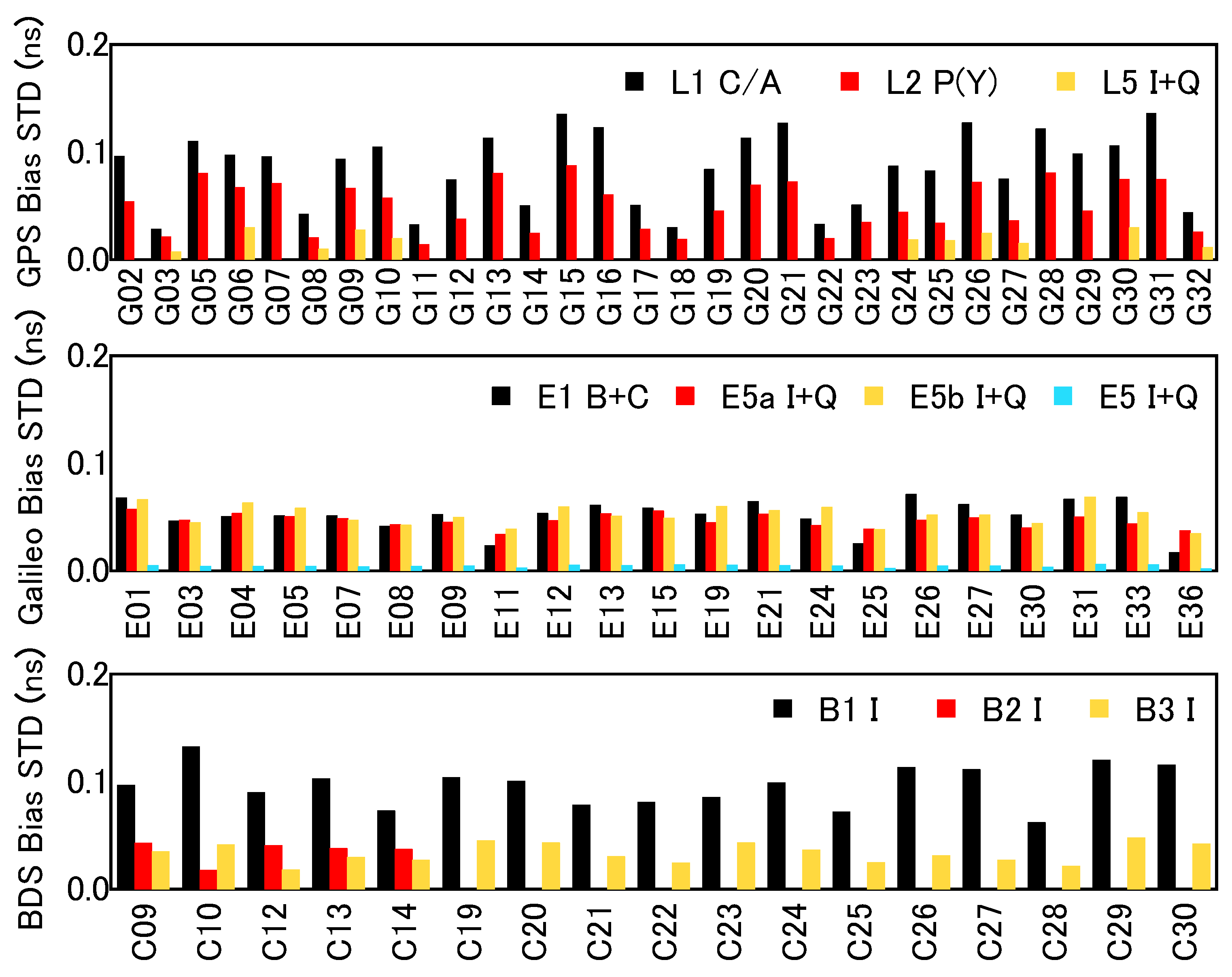

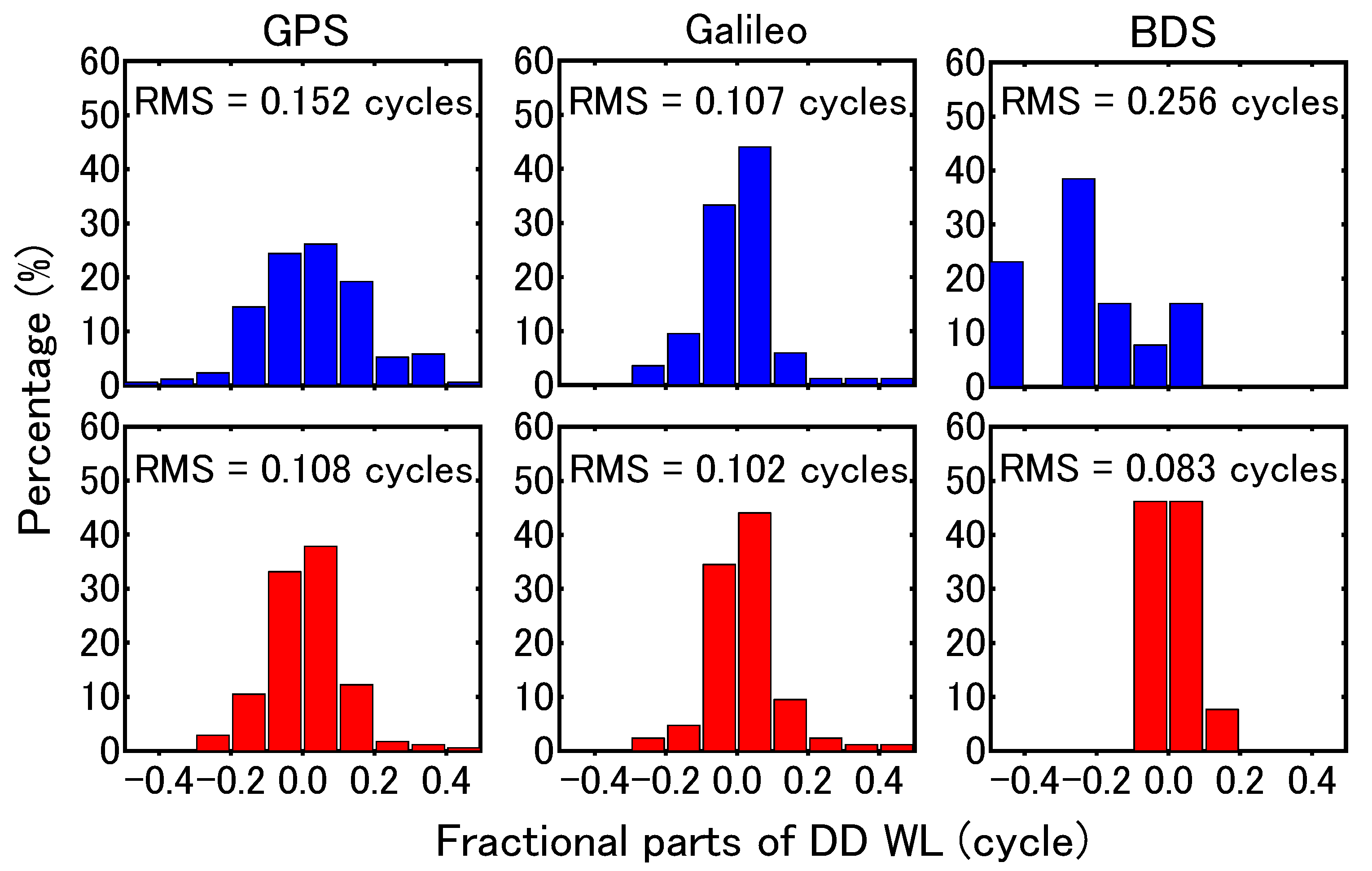
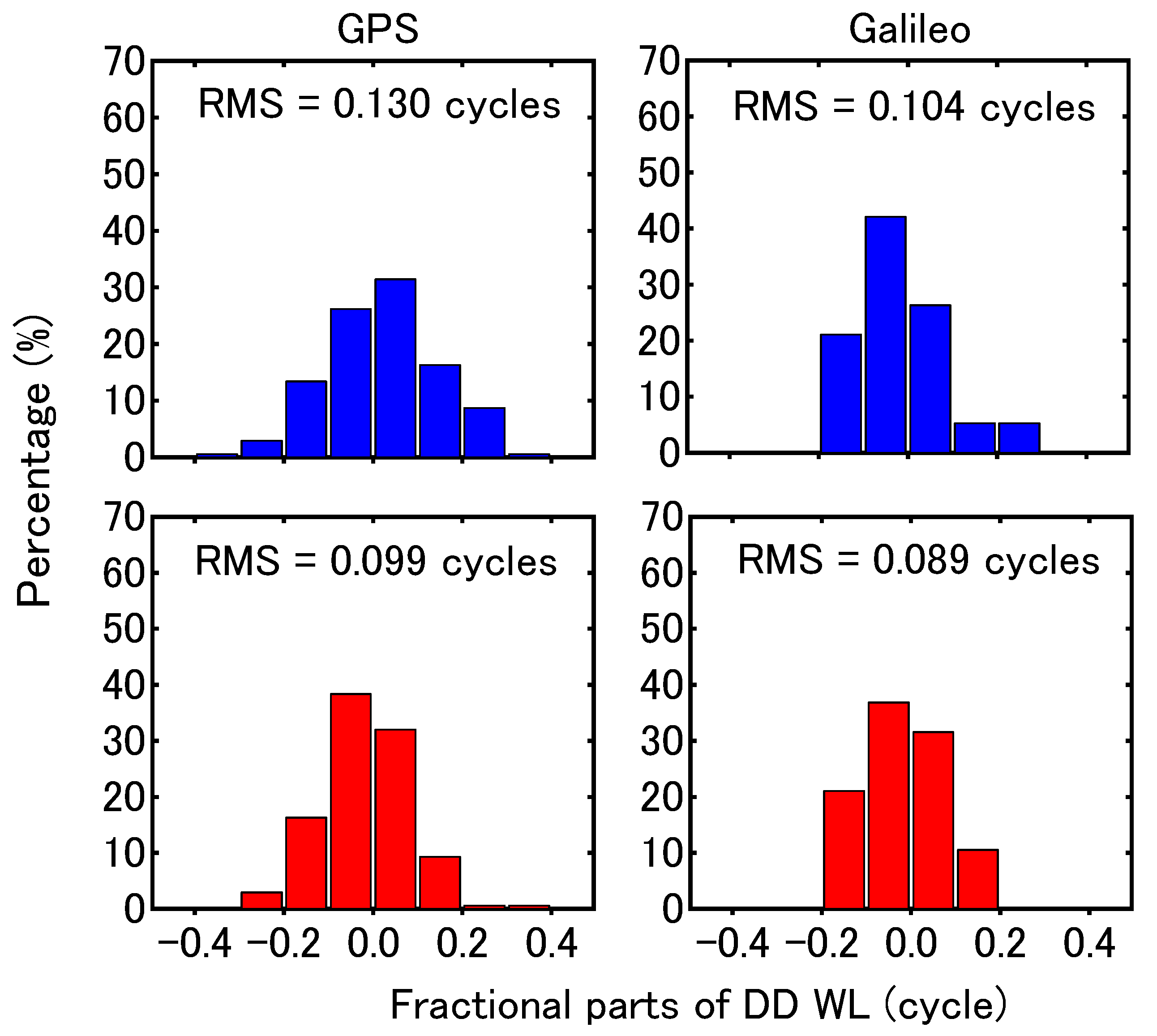
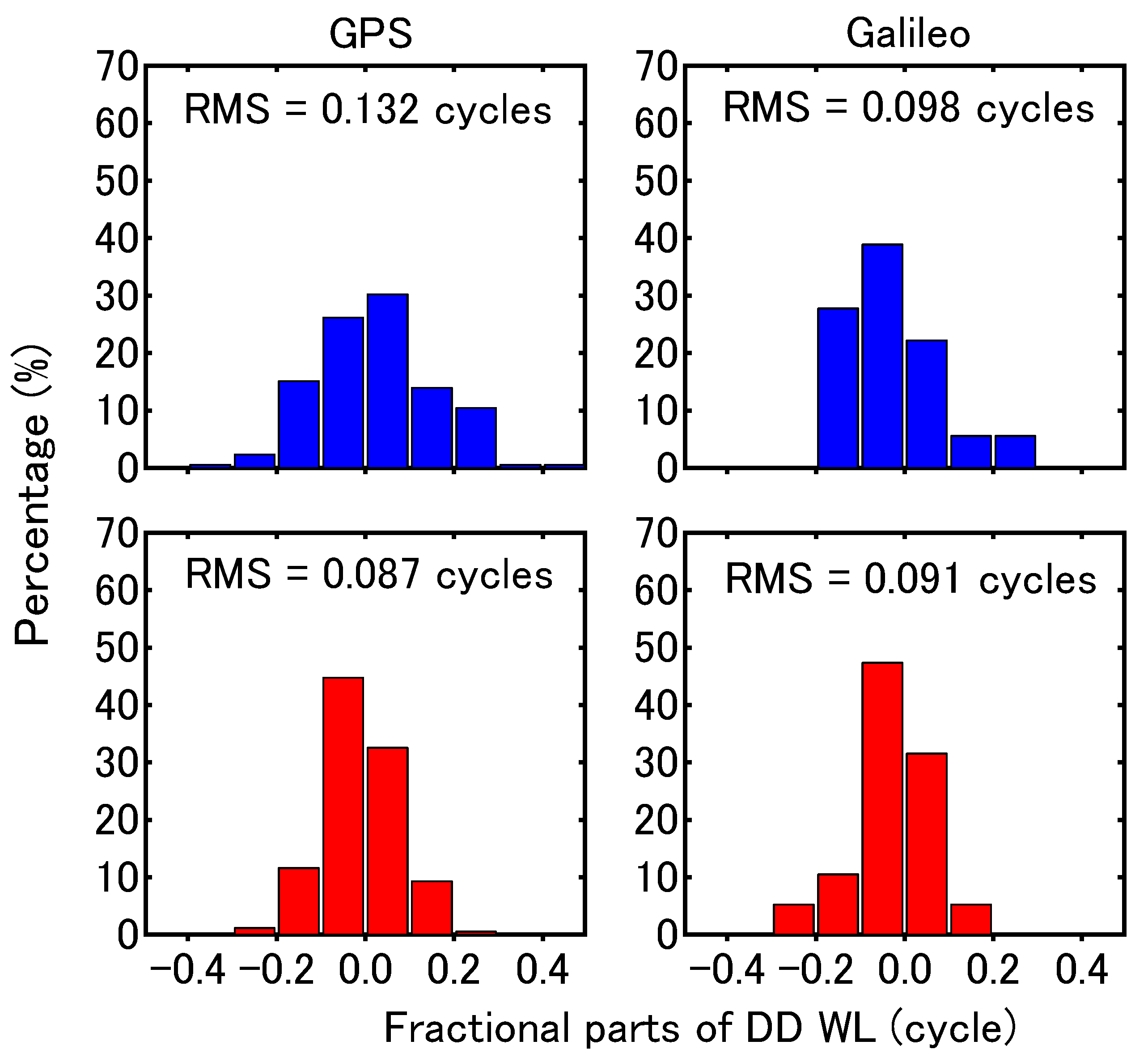
| Station | Length | Receiver Model | Antenna Type | Signal |
|---|---|---|---|---|
| ZIM3 | (0 m) | TRIMBLE NETR9 | TRM59800.00 | G: L1 C/A; L2 P(Y); L5 I + Q E: E1 B + C; E5a I + Q; E5b I + Q; E5 I + Q C: B1 I; B2 I; B3 I |
| ZIM2 | TRIMBLE NETR9 | TRM59800.00 | G: L1 C/A; L2 P(Y); L5 I + Q E: E1 B + C; E5a I + Q; E5b I + Q; E5 I + Q C: B1 I; B2 I; B3 I | |
| ZIMM | TRIMBLE NETR9 | TRM29659.00 | G: L1 C/A; L2 P(Y); L5 I + Q | |
| USN7 | (0.65 m) | SEPT POLARX5TR | TPSCR.G5 | G: L1 C/A; L2 P(Y); L5 Q E: E1 C; E5a Q; E5b Q; E5 Q; E6 C C: B1 I; B2 I; B3 I |
| USN8 | SEPT POLARX5TR | TPSCR.G5 | G: L1 C/A; L2 P(Y); L5 Q E: E1 C; E5a Q; E5b Q; E5 Q; E6 C C: B1 I; B2 I; B3 I | |
| GODS | (76.02 m) | JAVAD TRE_3 DELTA | TPSCR.G3 | G: L1 C/A; L2 P(Y); L5 I + Q E: E1 B + C; E5a I + Q; E5b I + Q; E5 I + Q; E6 B + C C: B1 I; B2 I; B3 I |
| GODN | JAVAD TRE_3 DELTA | TPSCR.G3 | G: L1 C/A; L2 P(Y); L5 I + Q E: E1 B + C; E5a I + Q; E5b I + Q; E5 I + Q; E6 B + C C: B1 I; B2 I; B3 I | |
| KOKB | (0 m) | SEPT POLARX5TR | ASH701945G_M | G: L1 C/A; L2 P(Y); L5 Q E: E1 C; E5a Q; E5b Q C: B1 I; B2 I |
| KOKV | JAVAD TRE_G3TH DELTA | ASH701945G_M | G: L1 C/A; L2 P(Y); L5 Q E: E1 B + C; E5a I + Q; E5b I + Q C: B1 I; B2 I | |
| MAR6 | (10.96 m) | SEPT POLARX5 | AOAD/M_T | G: L1 C/A; L2 P(Y); L5 Q E: E1 C; E5a Q; E5b Q; E5 Q C: B1 I; B2 I |
| MAR7 | TRIMBLE NETR9 | LEIAR25.R3 | G: L1 C/A; L2 P(Y); L5 I + Q E: E1 B + C; E5a I + Q; E5b I + Q; E5 I + Q C: B1 I; B2 I | |
| KIR0 | (4.26 m) | SEPT POLARX5 | JNSCR_C146-22-1 | G: L1 C/A; L2 P(Y); L5 Q E: E1 C; E5a Q; E5b Q; E5 Q C: B1 I; B2 I; B3 I |
| KIR8 | TRIMBLE NETR9 | LEIAR25.R3 | G: L1 C/A; L2 P(Y); L5 I + Q E: E1 B + C; E5a I + Q; E5b I + Q; E5 I + Q C: B1 I; B2 I; B3 I |
| USN7_USN8 (SEPTENTRIO) | GODS_GODN (JAVAD) | |||||||||
|---|---|---|---|---|---|---|---|---|---|---|
| L1 C/A | L2 P(Y) | L5 Q | - | - | L1 C/A | L2 P(Y) | L5 I + Q | - | - | |
| E1 C | E5a Q | E5b Q | E5 Q | E6 C | E1 B + C | E5a I + Q | E5b I + Q | E5 I + Q | E6 B + C | |
| B1 I | B2 I | B3 I | - | - | B1 I | B2 I | B3 I | - | - | |
| G06 | −0.079 | −0.011 | 0.170 | - | - | −0.097 | 0.143 | −0.173 | - | - |
| G12 | 0.201 | 0.006 | - | - | - | −0.318 | −0.043 | - | - | - |
| G13 | 0.242 | 0.023 | - | −0.049 | −0.045 | |||||
| G24 | 0.006 | −0.022 | −0.114 | - | - | 0.104 | 0.426 | −0.011 | - | - |
| E04 | −0.066 | −0.066 | −0.008 | 0.004 | −0.061 | 0.214 | 0.221 | 0.072 | −0.282 | 0.031 |
| E05 | −0.021 | −0.132 | 0.042 | 0.004 | −0.025 | 0.052 | 0.055 | −0.033 | −0.109 | −0.002 |
| E13 | 0.090 | 0.038 | −0.010 | 0.002 | −0.074 | −0.041 | −0.042 | −0.039 | 0.064 | 0.088 |
| E14 | −0.016 | −0.065 | 0.071 | 0.021 | −0.094 | - | - | - | - | - |
| E21 | 0.119 | 0.018 | −0.064 | 0.005 | −0.048 | −0.005 | −0.039 | −0.026 | 0.005 | 0.027 |
| E24 | 0.080 | −0.073 | 0.020 | 0.002 | −0.003 | 0.214 | 0.079 | 0.145 | −0.108 | −0.033 |
| C14 | 0.045 | 0.032 | −0.062 | - | - | −0.016 | −0.020 | 0.015 | ||
| C19 | 0.056 | - | - | - | - | 0.572 | 0.067 | −0.136 | ||
| C33 | 0.008 | - | 0.105 | - | - | 0.278 | −0.167 | −0.053 | - | - |
| C36 | 0.132 | - | - | - | - | 0.502 | 0.246 | −0.182 | ||
| C37 | 0.078 | - | - | - | - | 0.105 | −0.117 | −0.183 | - | - |
Publisher’s Note: MDPI stays neutral with regard to jurisdictional claims in published maps and institutional affiliations. |
© 2021 by the authors. Licensee MDPI, Basel, Switzerland. This article is an open access article distributed under the terms and conditions of the Creative Commons Attribution (CC BY) license (http://creativecommons.org/licenses/by/4.0/).
Share and Cite
Cheng, L.; Wang, W.; Liu, J.; Lv, Y.; Geng, T. GNSS Receiver-Related Pseudorange Biases: Characteristics and Effects on Wide-Lane Ambiguity Resolution. Remote Sens. 2021, 13, 428. https://doi.org/10.3390/rs13030428
Cheng L, Wang W, Liu J, Lv Y, Geng T. GNSS Receiver-Related Pseudorange Biases: Characteristics and Effects on Wide-Lane Ambiguity Resolution. Remote Sensing. 2021; 13(3):428. https://doi.org/10.3390/rs13030428
Chicago/Turabian StyleCheng, Lingyue, Wei Wang, Jingnan Liu, Yifei Lv, and Tao Geng. 2021. "GNSS Receiver-Related Pseudorange Biases: Characteristics and Effects on Wide-Lane Ambiguity Resolution" Remote Sensing 13, no. 3: 428. https://doi.org/10.3390/rs13030428
APA StyleCheng, L., Wang, W., Liu, J., Lv, Y., & Geng, T. (2021). GNSS Receiver-Related Pseudorange Biases: Characteristics and Effects on Wide-Lane Ambiguity Resolution. Remote Sensing, 13(3), 428. https://doi.org/10.3390/rs13030428







